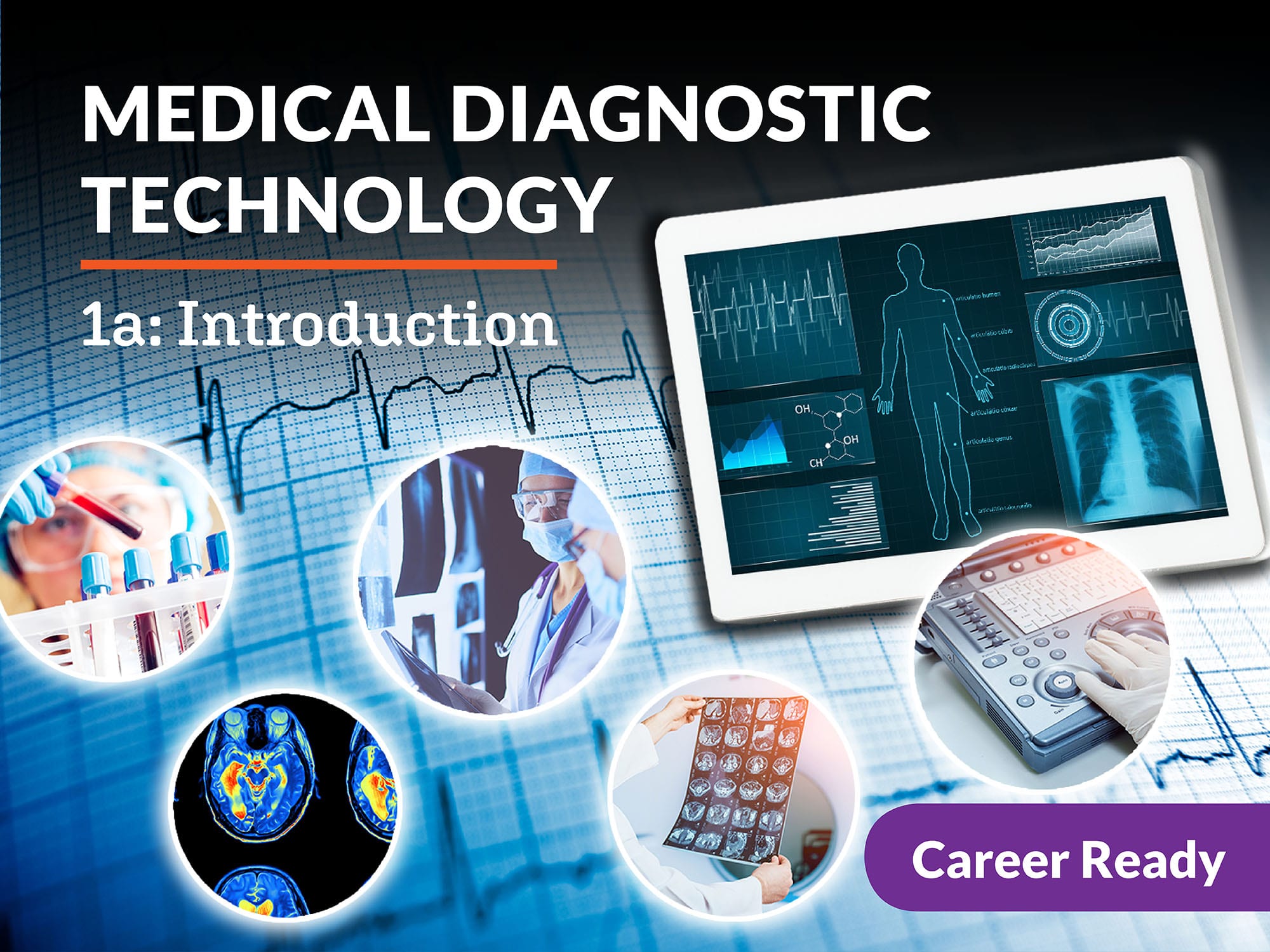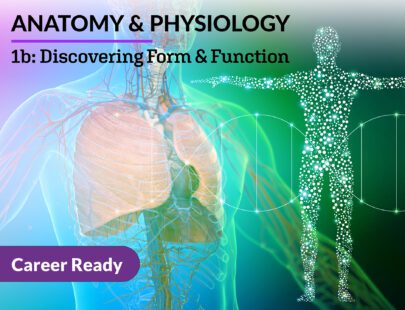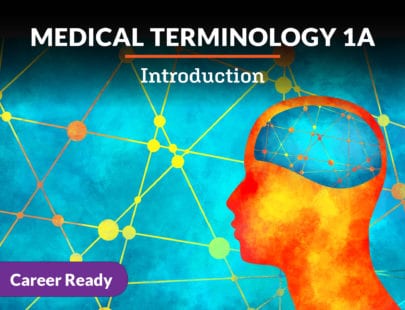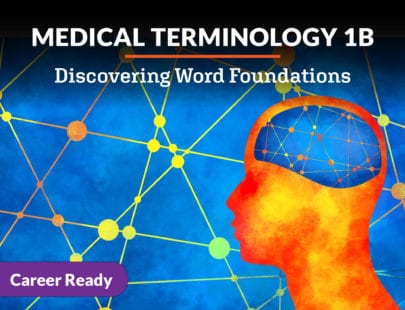
Medical Diagnostic Technology 1a: Introduction
Have you ever wondered how a health professional knows how to diagnose an illness? Or what medications to prescribe to a patient depending on the person’s body and their signs and symptoms? Learn about different diagnostic technology used and essential body systems and fluids that need to be understood to make an accurate diagnosis of a disease, condition, or illness. This career field is flourishing, and now is the time to be part of it!
Units at a Glance
Unit 1: Building a Team: The History & Professionals of Medical Diagnostic Technology
To treat a condition or illness, we need information that provides a diagnosis. The medical world is made up of many professionals specializing in body systems, as well as the technology that diagnoses and treats these systems. Have you ever wondered who these people are and what types of backgrounds provide the knowledge needed to perform these duties? As we explore the technology used to diagnose disease, we’ll also investigate the professionals who play a huge role in obtaining the needed information. Come along as we examine the history of medical diagnostic technology and the people who make using this technology possible!
What will you learn in this unit?
- Understand the major historical developments in medical diagnostic technology
- Describe the roles, responsibilities, and skills used by laboratory, radiology, respiratory, and cardiology professionals
- Identify the leading professional organizations
- Analyze the trends in hiring medical diagnostic professionals
Unit 2: Be Aware: Maintaining a Safe Environment
What types of hazards do employees and patients face when they enter health care facilities? What keeps these places safe? Luckily, health care organizations take many actions to keep employees and patients away from danger. As we explore the many hazards within a health care facility, we’ll also investigate the precautions that are taken to reduce and prevent harm. We will continue our study by examining the organizations that make sure everything is as it should be. After all, whether you’re just there for a visit or working there every day, you want to be safe and sound when you enter a healthcare facility!
What will you learn in this unit?
- Identify hazards in the health care environment and the methods used to keep patients and health care professionals safe
- Describe proper body mechanics and describe methods to move patients safely
- Explain the elements of general equipment and radiographic equipment quality control programs
- Explore governing agencies in health care and their role in the delivery of care
- Consider the importance of incident reporting in health care
Unit 3: Preventing Harm: Infection Control Procedures
Everyone wants to avoid infection, right? To learn how to use infection control measures properly, we need to look at what causes infection, how it’s spread, and ways to prevent it. Our journey will take us through the immune system and the natural protection offered by the body, as well as into the types of pathogens that try to break down those defenses. We’ll also differentiate between types of infections and identify specific methods to prevent their spread. Let’s learn to prevent harm by using infection control!
What will you learn in this unit?
- Identify and describe the components that make up a person’s immunity, including parts of the lymphatic system and the role of normal flora
- Understand each link in the chain of infection
- Differentiate between health care or hospital-acquired infections and non-health care-acquired infections
- Describe the types of precautions used and types of isolation in the health care environment
- Investigate various departments in a medical laboratory, along with examples of tests and how lab samples are handled
Unit 4: Image With Care: Radiation Safety
Have you ever wondered what kinds of tests are done in diagnostic imaging departments? Although we tend to think of radiology as taking X-rays of bones, this area involves so much more! We’ll investigate the areas within diagnostic imaging, as well as analyze how the tests are used to diagnose, treat, and monitor patient conditions. We’ll also look at how radiation safety measures are employed to reduce doses to technologists and patients. Let’s explore this world and find out how these professionals image with care!
What will you learn in this unit?
- Differentiate between the modalities that make up diagnostic imaging and explain how the radiology department is organized
- Identify how imaging modalities are used to diagnose, monitor, and treat patient conditions
- Present the radiation safety principles of reducing patient and occupational doses
- Describe the types of protective devices that reduce patient and occupational doses
- Analyze how radiologic technologists use critical thinking to adjust to situations and ensure that radiation levels are kept as low as reasonably achievable
Unit 5: Fluid Samples: Using Blood and Urine as Clues in Diagnosis
A big part of medical diagnostic technology is performing tests on blood and urine samples. As we explore these testing methods, we’ll look at how samples are collected and handled. We’ll also examine the diagnoses that can be made using the results as well as the related signs and symptoms. It’s time to explore the diagnostic information these body fluids have to offer!
What will you learn in this unit?
- Identify the chemical composition of the body as well as the structures and functions of cells, blood, its components, and the urinary system
- Discuss common blood tests and the reasons they are ordered
- Describe venipuncture, including the adjustments that are made for neonatal, pediatric, and geriatric patients
- Name the common urine tests and the reasons they are ordered
- Explain the signs and symptoms of common blood and urinary disorders
Unit 6: Positive Patient Interactions
Many factors go into making the patient’s experience a positive one. Health care professionals must be aware of barriers in the communication process and ways to overcome them. Once communication begins, careful documentation and coordination with other members of the health care team are needed to provide care within the bounds of legal and ethical standards for the profession. And on top of all of those things, the professional needs to ensure patient confidentiality using HIPAA guidelines! Let’s see exactly how health care professionals do all of this as we investigate ways to promote positive patient interactions.
What will you learn in this unit?
- Explain the importance of documentation in health care
- Describe factors that affect communication and ways to adapt to communication barriers
- Discuss methods to improve communication in a multidisciplinary health care team
- Understand the importance of confidentiality and the impact of HIPAA regulations in medical diagnostic technology
- Identify legal and ethical standards in the medical diagnostic technology field
Unit 7: Investigating the Senses and the Nerves
What gives us the ability to assess our surroundings? What kinds of information do we gather without even noticing? The sense organs give humans the ability to see, hear, smell, taste, and touch the world around them to gain a better understanding of the environment. As part of our journey, we’ll explore the nervous system and learn how the senses work together to process this information. We’ll also discover related health conditions that occur and ways to diagnose them. Let’s investigate the senses!
What will you learn in this unit?
- Describe the structure and function of the eye, as well as the organs that control hearing, taste, touch, and smell
- Explain an ophthalmic examination, including the importance of a visual acuity test
- Identify common diseases and conditions of the sense organs along with possible treatments
- Understand the structure and function of the nervous system
- Investigate common diseases and conditions of the nervous system related to the sense organs
Unit 8: Exploring Medical Imaging
Medical imaging is just another name for x-rays, right? Actually, there’s a lot more to it than just that! As we explore the many areas that make up medical imaging, we’ll investigate the advantages and disadvantages of different radiology systems, as well as some conditions they are used to detect. Let’s find out how much more there really is to the amazing world of medical imaging!
What will you learn in this unit?
- Describe the structure and function of the musculoskeletal, digestive, and cardio-respiratory systems
- Explain how the body is organized, including body planes, cavities, and anatomical structures
- Differentiate between types of medical imaging equipment, giving advantages and disadvantages of each type
- Use medical terminology to describe common diseases and disorders diagnosed through medical imaging
Required Materials
- An internet connection
- Word processing software
- Poster board
- Markers or Crayons
- Camera or computer with video recording capabilities
- Paper
- Ruler
- Pencil/Pen



